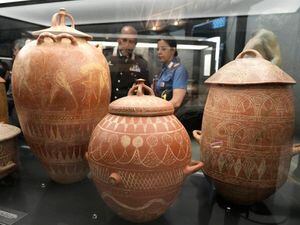Italy creates new museum for trafficked ancient artefacts
The Museum of Rescued Art is in a cavernous structure that is part of Rome’s ancient Baths of Diocletian.

Italy has been so successful in recovering ancient artworks and artefacts that were illegally exported from the country it has created a museum for them.
The Museum of Rescued Art was inaugurated on Wednesday in a cavernous structure that is part of Rome’s ancient Baths of Diocletian.
The Octagonal Hall exhibition space was designed to showcase Italy’s efforts, through patient diplomacy and court challenges, to get valuable antiquities returned to Italy, often after decades in foreign museums or private collections.

The inaugural exhibit revolves around some 100 of 260 artefacts recovered by the nation’s paramilitary Carabinieri art squad from the United States and brought back to Italy in December 2021.
The pieces on display, which were found during clandestine digs and illegally exported, include exquisitely carved Etruscan figurines and imposing painted jars. The items were previously held by museums, auction houses and private collections.
The new Rome museum is exhibiting objects “never before seen in Italy”, said Massimo Osanna, director general of Italy’s state museums.

The recently recovered antiquities are from before the Roman era, dating back to the 8th to 7th centuries BC. Many of them came from the area near modern-day Cerveteri, which is awash with remnants of the flourishing Etruscan civilisation in west-central Italy.
One particularly striking piece is a ceramic jar, painted red on white and towering more than a metre high. Decorated with images of horses and cats, it depicts the mythological scene of the blinding of Polyphemus, a man-eating one-eyed creature.
The choice of the jar’s decoration probably indicates that the Etruscan elite were bilingual and “fascinated with Greek myth”, Mr Osanna said. They were ”Etruscan heroes that identified with Greek heroes”, he added.

“We thought it’s right to have the pieces return to the places where they were stolen from,” Mr Franceschini said.
In some cases, experts do not know the exact original location of the antiquities, underlining the irreparable damage done when archaeological treasures are clandestinely snatched away. Pieces with unknown origins will be returned to the general geographic area.
The exhibition space is part of the National Roman Museum. Its current exhibit runs until October 15, then the museum will display a different batch of recovered antiquities.





